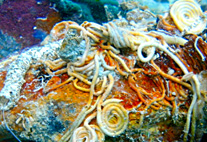Abstract
A new species, Dasineura camassiae Gagné (Diptera: Cecidomyiidae), is described, illustrated and compared to some of its congeners from related hosts and western North America. The new species causes flower galls on Camassia (Agavoideae; Asparagaceae) in the Pacific Northwest. Its current known distribution is Oregon and Washington, USA. Larvae develop in spring in flowers of Camassia spp., causing the young ovaries to enlarge prematurely and eventually abort, without forming seeds or mature fruit. Full-grown larvae crawl out of the gall in rapid succession and drop to the soil where they pupate; they remain there until spring of the following year when the adults emerge and lay eggs. The galls they induce in camas lily buds represent the first known association of the cosmopolitan genus Dasineura with the group of plants that includes Agave and its relatives.

